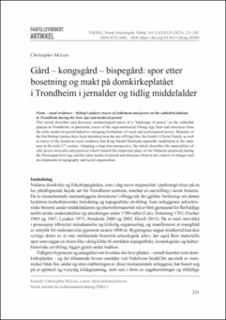| dc.contributor.author | McLees, Christopher | |
| dc.date.accessioned | 2023-11-23T10:52:41Z | |
| dc.date.available | 2023-11-23T10:52:41Z | |
| dc.date.created | 2023-11-21T17:15:57Z | |
| dc.date.issued | 2023 | |
| dc.identifier.citation | Viking. 2023, 87: 211-242. | en_US |
| dc.identifier.issn | 0332-608X | |
| dc.identifier.uri | https://hdl.handle.net/11250/3104300 | |
| dc.description.abstract | Farm – royal residence – bishop’s palace: traces of settlement and power on the cathedral plateau in Trondheim during the Iron Age and medieval period This article describes and discusses archaeological traces of a ‘landscape of power’ on the cathedral plateau in Trondheim; in particular, traces of the saga-mentioned Viking-Age farm and structures from the early medieval period linked to emerging institutions of royal and ecclesiastical power. Remains of the first bishop’s palace have been identified near the site of King Olav the Gentle’s Christ Church, as well as traces of the medieval royal residence that King Harald Hardrada reputedly established in the same area in the mid-11th century. Adopting a long-term perspective, the article describes the materialities of elite power networks and practices which formed this important place on the Nidarnes peninsula during the Norwegian Iron Age and the early medieval period and discusses them in the context of changes and developments in topography and social organisation. | en_US |
| dc.language.iso | nob | en_US |
| dc.title | Gård – kongsgård – bispegård: spor etter bosetning og makt på domkirkeplatået i Trondheim i jernalder og tidlig middelalder | en_US |
| dc.type | Peer reviewed | en_US |
| dc.type | Journal article | en_US |
| dc.description.version | publishedVersion | en_US |
| dc.source.pagenumber | 211-242 | en_US |
| dc.source.volume | 87 | en_US |
| dc.source.journal | Viking | en_US |
| dc.identifier.doi | https://doi.org/10.5617/viking.10580 | |
| dc.identifier.cristin | 2199901 | |
| cristin.ispublished | true | |
| cristin.fulltext | original | |
| cristin.qualitycode | 1 | |
